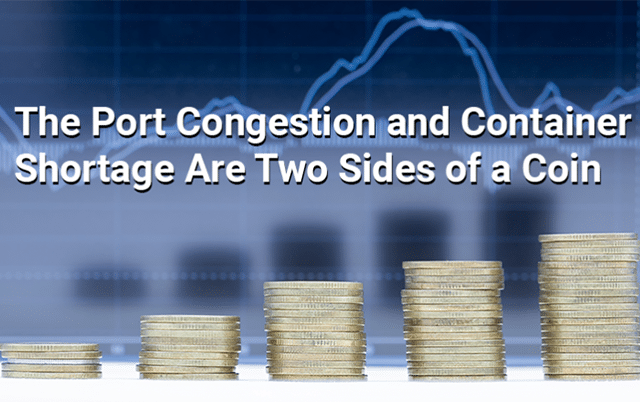The Port Congestion and Container Shortage Are Two Sides of a Coin
June 26, 2023 Freight Forwarding
Cargo shipping is faced with an increasingly daunting challenge in recent times. The current volatile circumstances have taken a considerable toll on both shipment time and shipping rates. And logistics providers around the world are being forced to brace for the impact.
Although there are several factors involved on a large scale, the major contributors to this change can be considered congestion at the ports and a drastic lack of shipping containers. Moreover, the cause and effects of these contributors and other factors are cyclic in nature. In fact, diving deeper into the cause/effect of these challenges reveals that they may just be two sides of the same coin.
But to properly grasp this possibility, we must first take a look at the significance of these factors independently:
Port Congestion
A port congestion may be thought of as a ship’s equivalent of vehicle traffic on land. It refers to a particular situation where the vessel or ship arriving at the port is unable to dock and has to wait to berth instead. This means that the unloading of cargo aboard the vessel will be delayed, and all following operations such as transport, cleaning, reloading, and so on will also be delayed.
Ports may become congested for various reasons:
- The port capacity is exceeded.
- Delays in vessel arrival which create backlogs for other vessels.
- Mishandling of port equipment.
- Strikes, bans, or any other reason for a lack in the workforce.
- Slow operations and inefficient equipment handling.
- Unpredictable and unavoidable circumstances such as the COVID-19 pandemic.
Another important contributing factor to congestion in ports is the availability of shipping containers.
Container Shortage
The current global scenario has resulted in a drastic inflation of container prices. And this does not bode well for shipping companies who have already been dealing with the loss of business and employees. The strain of reduced shipping containers translates into an inability to take up new orders and delays in the existing orders. This is also cyclic in nature, meaning that the ultimate consequence of a container shortage, regardless o the reason, is a loss of business.
The current lack of containers can be attributed to:
- Inflation of container costs, making new containers less affordable.
- Delays in carrier schedule, making existing containers less available.
- Congestion at ports, making the use of containers less reliable.
The Scenario Thus Far
The result of this congestion-shortage dilemma is a massive reduction in freight movement across the ocean. This unique conundrum has also had a butterfly effect on the supply chain and left a big dent in global trade. Although not evident, the general trend in this logistical downfall seems to have started with the rise of the COVID-19 pandemic.
The production of goods and services had reached a standstill, leading shipping companies to reduce the number of ships deployed. These restrictions both reduced the import/export of goods across borders and reduced the return of empty containers post-shipment. As a result, fewer containers were available for future shipments; business operations were delayed leading to congestion at ports, and so on.
Common Ground
Both congestion and container shortages have had a significant impact on the global economy. International trade in specific has seen the worst of this change. The majority of trade cargo is transported overseas using port-to-port shipping. However, port operations have taken a back seat with the current situation, and the transport of goods is running on borrowed time.
A similarly disturbing situation was observed back in 2019 where 8,000 empty containers were reported to be piled on a particular port, leading to a congestion, delay in transport, and even a Customs regulation. Moreover, cargo rollover due to interrupted shipping schedules proves to be damaging to businesses in the long run but is used anyway as a last resort.
In Conclusion
The scenario is predicted to get worse before it gets better. But it is evident from previous, similar experiences that the issue will be resolved in due time. Until then, it is crucial to recognize that regardless of whether it is port congestion or container shortage that delays shipments, the consequences remain the same. And the only way to mitigate the problem is by the active cooperation of all parts of the supply chain.


